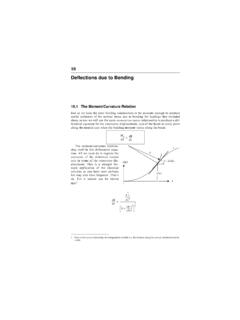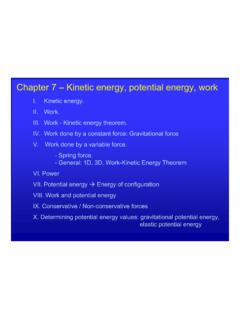Transcription of Lecture 8: Energy Methods in Elasticity - MIT …
1 Structural Mechanics Lecture 8 Semester Yr Lecture 8: Energy Methods in Elasticity The Energy Methods provide a powerful tool for deriving exact and approximate solutions to many structural problems. The Concept of Potential Energy From high school physics you must recall two equations 1. E = M v 2 kinematic Energy ( ). 2. W = mgH potential Energy ( ). where H is the hight of a mass m from a certain reference level Ho , and g stands for the earth acceleration. The reference level could be the center of the earth, the sea level or any surface from which H is measured. m F = mg H x x H Ho Ho F. Figure : Gravitational potential Energy . We seldom measure H from the center of earth. Therefore what we can easily measure is the change of the potential Energy W = (mg)(H Ho ) ( ). The Energy is always positive. It can e zero but it cannot be negative. The gravity force F = mg is directed towards the center of earth.
2 Therefore there is a need for the negative sign in Eq. ( )). In the coordinate system of Fig. ( ), the gravity force is negative (opposite to the sense of coordinate x). The force F is acting in the sense of x but the difference H Ho is negative. Extending the concept of the potential Energy to the beam, the force is F = q dx and the w = H Ho is the beam deflection. Z l W + qw dx ( ). 0. An analogous expression for plates is Z. W + pw ds ( ). S. 8-1. Structural Mechanics Lecture 8 Semester Yr q q(x). x z dx w w Ho z H. Figure : Potential Energy of a beam element and the entire beam. In the above definition W is negative. The concept of the Energy stored elastically U has been introduced earlier. For a 3-D. body 1. Z. U= ij ij dv ( ). V 2. and for a beam Z l Z l 1 1 . U= M K dx + N dx ( ). 0 2 0 2. For plates, the bending and membrane energies are given by Eqs. ( ), ( ) and ( ), ( ).
3 The total potential Energy is a new concept, and it is defined as the sum of the drain Energy and potential Energy = U + ( W ) = U W ( ). Consider for a while that the material is rigid, for which U 0. Imagine a rigid ball being displaced by an infinitesimal amount on a flat ( = 0) and inclined ( 6= 0) surface, Fig. ( ). x u H. x u H. Figure : Test if an infinitesimal displacement u causes the potential Energy to change. We have H = u sin and H = u sin . The total potential Energy and its change is = W = F u sin ( ). = W = (F sin ) u ( ). On the flat surface, = 0 and = 0, and the ball is in static (neutral) equilibrium. If > 0, 6= 0 and the ball is not in static equilibrium. Note that if the d'Alambert inertia 8-2. Structural Mechanics Lecture 8 Semester Yr force in the direction of motion is added, the ball will still be in dynamic equilibrium. In this Lecture , only static equilibrium is considered.
4 We can now extend the above test for equilibrium and introduce the following principle: The system is said to be in equilibrium, if an infinitesimal change of the argument a of the total potential Energy = (a) does not change the total potential Energy . (a) = a = 0 ( ). a Because a 6= 0 ( a = 0 is a trivial case in which no test for equilibrium is performed), the necessary and sufficient condition for stability is . =0 ( ). a In case when the functional is a function of many (say N ) variables = (ai ), the increment . = ai , i = 1, .., N ( ). ai The system is in equilibrium if the derivative of with respect to each variable at a time vanishes (ai ). = 0, i = 1, .., N ( ). ai The meaning of the argument(s) ai , or independent variables will be explained next. Equivalence of the Minimum Potential Energy and Prin- ciple of Virtual Work The concept of virtual displacement ui is the backbone of the Energy Methods in mechanics.
5 The virtual displacement is a small hypothetical displacement which satisfy the kinematic boundary condition. The virtual strains ij are obtained from the virtual displacement by 1. ij = ( ui,j + uj,i ) ( ). 2. The increment of stress ij corresponding to the increment of strain is obtained from the Elasticity law ij = Cijkl kl ( ). ij = Cijkl kl ( ). Therefore, by eliminating Cijkl ij ij = ij ij ( ). The total strain Energy of the elastic system is the sum of the elastic strain Energy stored and the work of external forces 1. Z Z. = ij ij dv Ti ui ds ( ). V 2 S. 8-3. Structural Mechanics Lecture 8 Semester Yr .. Figure : Equivalence of the strain Energy and complementary strain Energy . In the above equation the surface traction are given and considered to be constant. The stresses ij are not considered to be constant because they are related to the variable strains. For equilibrium the potential Energy must be stationary, = 0 or 1.
6 Z Z. ij ij dv Ti ui ds 2. ZV ZS. 1. = ( ij ij ) dv Ti ui ds ( ). 2 V S. 1. Z Z. = ( ij ij + ij ij ) dv Ti ui ds = 0. 2 V S. The two terms in the integrand of the volume integral are equal in view of Eq. ( ). Therefore, Eq. ( ) can be written in the equivalent form Z Z. ij ij dv = Ti ui ds ( ). V S. which is precisely the principle of virtual work. The above proof goes also in the opposite direction. Assuming the principle of virtual work one can show that the stationarity of the total potential Energy holds. Two Formulations for Beams In the bending theory of beams, the total potential Energy is Z l Z l 1. = M dx q(x)w dx ( ). 0 2 0. Using the moment curvature relation M = EI , either M or can be eliminated from Eq. ( ), leading to Z l EI 2. dx displacement formulation Z l .. 1. Z0 l 2.. U= M dx = ( ). 0 2 1 2. M dx stress formulation .. 0 2EI. 8-4. Structural Mechanics Lecture 8 Semester Yr In statically determined problems the bending moments can be expressed in terms of the prescribed line load or point load.
7 In the latter case the M = M (P ) and the total potential Energy takes the form = U (P ) P w ( ). The above representation will lead to the Castigliano theorem which will be covered later in this Lecture . The more general displacement formulation will be covered next. The curvature is proportional to the second derivative of the displacement . The expression of the total potential Energy becomes l l EI 00 2. Z Z. = (w ) dx q(x)w dx ( ). 0 2 0. The problem is reduced to express the displacement field in terms of a finite number of free parameters w(x, ai ) and then use the stationary condition, Eq. ( ) to determine these unknown parameters. This could be done in three different ways: (i) Polinomial representation or Taylor series expansion (ii) Fourier series expansion (iii) FInite element or finite difference method Each of the above procedure will be explained separately. Fourier Series Expansion and the Ritz Method Consider a symetrically loaded simply supported plate by the point force at the center.
8 The total potential Energy of the system is l EI 00 2. Z. = (w ) dx P w ( ). 0 2. The objective is to find the amplitude and shape of the deflection function that is in equi- librium with the prescribed load P . In other words we will be looking the deflection and shape that will make the total potential Energy stationary. Assume the solution as a Fourier expansion function N. X. w(x) = an n (x) ( ). n=1. where n (x) is a complete system of coordinate function satisfying kinematic boundary conditions. In the rectangular coordinate system this system consists of hormonic functions, 8-5. Structural Mechanics Lecture 8 Semester Yr in the polar coordinate system these are Bessel function, and in the spherical coordinate system this role is taken by the Legender functions. In our case n x n (x) = sin ( ). l The kinematic boundary conditions n (x = 0) = n (x = l) are identically satisfied.
9 Further- more, because of the symmetry of the problem, only the symmetric function will contribute to the solution. n=2 n=1. n=4 n=3. l Figure : Asymmetric modes do not satisfy boundary condition w0 (x = ) = 0 at the 2. center of the beam. The solution is then represented as x 3 x w(x) = a1 sin + a3 sin + ( ). l l Consider first one-term approximation x w(x) = a1 sin ( ). l x 0. w (x) = a1 cos ( ). l l 2 x w00 (x) = a1 sin ( ). l l The expression for the total potential Energy is 1 4 Z l x = EI a21 sin dx P a1 ( ). 2 l 0 l where the integral is simply l/2. Eq. ( ) reduces then to 1 4. = EI 3 a21 P a1 ( ). 4 l d . For equilibrium = 0, which yields da1. 1 4. EI 3 a1 P = 0 ( ). 2 l 8-6. Structural Mechanics Lecture 8 Semester Yr The load- displacement relation is finally given by P l3 P l3. (a1 )opt = 4. = ( ). 2 EI. The numerical coefficient in the exact solution of this problem is 48.
10 The error of the approximate solution is Such a good accuracy of just one-term approximation can be explained by making the Taylor series expansion of the sign function x x 1 x 3. sin = + ( ). l l 6 l The two term expansion has a linear and cubic terms in x, the same as the exact solution. Let's examine next the stationary property of the functional . Defining the normalized . total potential Energy as = , one gets P wo . 1 a1 a1. = 2 ( ). 2 wo wo where a1 is the amplitude of the trial function Eq. ( ) and wo is the exact amplitude. The plot of the function (a1 ) is shown in Fig. ( ).. a1. 0 wo 1. 2 Stationary point a1. Figure : By varying the amplitude around = 1, does not change. wo The function (a1 ) is a parabola with a stationary point at a1 = wo . The stationary point is at the same time the minimum. The negative value of the minimum (actual) value of the total potential Energy comes from the choice of the reference level of the potential Energy .


















